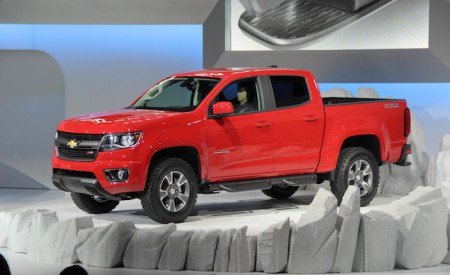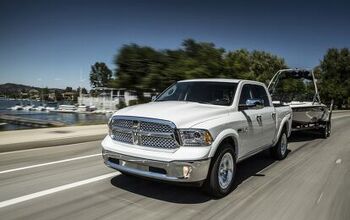Cain's Segments, June 2014: Small And Mid-Size Pickup Trucks
Small and midsize pickup trucks accounted for 10.6% of the new pickups sold in the United States in June 2014 as their collective volume slid 9.3%.
Overall pickup truck sales slid 5.1%. Sales of the core set of six full-size trucks fell 3.5%.
One year ago, in June 2013, this group of non-full-size trucks generated 11.1% of the pickup truck volume.
During the first half of 2014, sales of these smaller pickup trucks were down 3.9%, a loss of 4806 units, as sales of the Ford F-Series-led full-size group jumped 4.3% and the overall pickup sector grew at a 2% clip.
Excluding the three parts of this small/midsize category – Colorado, Canyon, Equator – that have either disappeared or were in the throes of a long hiatus one year ago results in a 0.4% year-over-year decline over the first half of 2014. The Nissan Frontier’s meaningful gains were offset by the Tacoma’s 7.4% loss and the Honda Ridgeline’s 12% decrease.
How is the Tacoma’s decline explained? For starters, remember that Tacoma sales through the first half of 2013 had risen very nicely with a 21% jump compared to the first half of 2012. Tacoma sales in 2013 reached a six-year high. At the current pace, 2014 Tacoma sales will be higher than they’ve been at any point since 2007, that is, if we ignore last year’s results.
But Cars.com’s inventory results for the Tundra and Tacoma show twice as many available Tundras as there are Tacomas. We know that the biggest difficulty for small and midsize trucks right now is the pricing proximity with their full-size siblings. The updated Tundra has produced a 12.5% boost in volume so far this year. In fact, the Tundra has joined the Ram in stealing market share, a little bit of market share, from Ford and General Motors in the full-size sector.
There’s your segue. These figures are meant to set a baseline before the new Colorado and Canyon arrive. The smaller pickup trucks that stuck around after the Dakota and Ranger departed and after the Colorado and Canyon temporarily vacated the premises have not truly taken advantage of the gaps in the market.
But will the Colorado and Canyon be able to fill those gaps? Will they be priced competitively, not with the Tacoma and Frontier, but with the Silverado and Sierra? Will the fuel efficiency benefit be so significant that owners will actually notice the difference compared with their neighbour’s full-size pickup?
If the answers to the latter two questions are negative, the answer to the first question will be, as well.
AutoJune2014June2013%Change6 mos.20146 mos.2013%ChangeToyota Tacoma12,17314,023-13.2%75,14981,188-7.4%Nissan Frontier5,7225,413+5.7%35,94329,316+22.6%Honda Ridgeline1,3091,572-16.7%7,9069,020-12.4%Chevrolet Colorado51155-67.1%733,034-97.6%GMC Canyon364-95.3%5876-99.4%Suzuki Equator————448-100%—— —————Total 19,25821,227 -9.3% 119,076 123,882 -3.9%More by Timothy Cain
Latest Car Reviews
Read moreLatest Product Reviews
Read moreRecent Comments
- Lichtronamo Watch as the non-us based automakers shift more production to Mexico in the future.
- 28-Cars-Later " Electrek recently dug around in Tesla’s online parts catalog and found that the windshield costs a whopping $1,900 to replace.To be fair, that’s around what a Mercedes S-Class or Rivian windshield costs, but the Tesla’s glass is unique because of its shape. It’s also worth noting that most insurance plans have glass replacement options that can make the repair a low- or zero-cost issue. "Now I understand why my insurance is so high despite no claims for years and about 7,500 annual miles between three cars.
- AMcA My theory is that that when the Big 3 gave away the store to the UAW in the last contract, there was a side deal in which the UAW promised to go after the non-organized transplant plants. Even the UAW understands that if the wage differential gets too high it's gonna kill the golden goose.
- MKizzy Why else does range matter? Because in the EV advocate's dream scenario of a post-ICE future, the average multi-car household will find itself with more EVs in their garages and driveways than places to plug them in or the capacity to charge then all at once without significant electrical upgrades. Unless each vehicle has enough range to allow for multiple days without plugging in, fighting over charging access in multi-EV households will be right up there with finances for causes of domestic strife.
- 28-Cars-Later WSJ blurb in Think or Swim:Workers at Volkswagen's Tennessee factory voted to join the United Auto Workers, marking a historic win for the 89- year-old union that is seeking to expand where it has struggled before, with foreign-owned factories in the South.The vote is a breakthrough for the UAW, whose membership has shrunk by about three-quarters since the 1970s, to less than 400,000 workers last year.UAW leaders have hitched their growth ambitions to organizing nonunion auto factories, many of which are in southern states where the Detroit-based labor group has failed several times and antiunion sentiment abounds."People are ready for change," said Kelcey Smith, 48, who has worked in the VW plant's paint shop for about a year, after leaving his job at an Amazon.com warehouse in town. "We look forward to making history and bringing change throughout the entire South." ...Start the clock on a Chattanooga shutdown.


































Comments
Join the conversation
I do think the chicken tax is a factor BUT before DiM chimes in, so are other factors like lack of small truck R&D, a US preference for supersizeme coupled with a preference for cheap vehicles with big V8's. One can add EPA footprint based rules to the equation. I don't think that a "true" small truck will be much more than a niche player. Even the global small trucks have gotten bigger. Proponents on both sides of the debate like to focus only on one or two issues and do not look at the big picture. What is the big picture? As I have pointed out, we have a consumer preference for big vehicles with big engines. Car companies have profited for decades with pickups because traditionally safety and environmental rules were more lax. As rules toughened that consumer preference was well solidified and due to huge profits in large pickups, companies had a ton of motivation to put R&D into them to stay competitive. Adding doors to pickups was the stroke of genius that solidified pickups as the replacement for the 60's land yachts. Some car companies have stated point blank that they will not introduce small trucks because they will chip in to golden goose sales. The 800 lb gorilla that DiM downplays is the fact that trade barriers keep out any economical alternatives. The operative word is ECONOMICAL. If profit margins are tighter in a small truck then a 25% tariff kills any hope of profit just like any creative ways to circumvent them. The "they can build in Mexico" argument also is a wash considering the cost of building a new factory. VW already said that they'd need to sell 100,000 a year to make it worth while. Car companies will not change too much as long as profits keep rolling in from their golden goose line-up. I do think that car companies do have "Plan B" contingencies. Spy photo's have recently appeared of what is most likely a highly camouflaged Fiat Strada. A while back spy photo's popped up of the global Ranger being tested. Ford is an active proponent of an FTA with the EU. Anyone wonder why? They've said that it would make niche marketing more easy for them. What constitutes niche markets for Ford? Marketing the Mustang in the EU and the Ranger in the US. Until we see the elimination of the chicken tax,and the homogenization of emission and safety rules this whole debate will remain more of a "he said she said" argument despite the fact that there are studies proving that trade barriers do shape the automotive landscape. As long as people feel they might occasionally need the capabilities of a 20 ft long V8 powered truck they will sell and sell well. The Ecoboost is proof that V8 lust is waning. The Ram 1500 lineup and its steady gains in the marketplace is also proof that people want a car like ride even if it means less true truck cargo capacity. As the article has pointed out, we are seeing a contracture of truck sales. Is this proof that the pickup truck bubble is about to burst like other unsustainable bubbles built more on wants as opposed to real need?
I don't see how the new Canyon/Colorado become big sellers when I was just able to get over $9k off a Sierra and it's been out barely a year. Where can they be priced in such a huge discount environment?